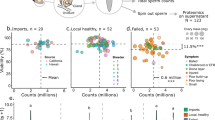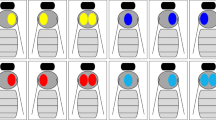Abstract
Normal mating of honey bee (Apis mellifera L.) queens and drones results in extreme polyandry. Larger queens are reported to produce more brood, but do they also store more semen? Measurements of queen weight, spermatheca weight and volume, and numbers of sperm in the spermatheca were made on normally reared queens and queens exposed to miticide from early larval stage to emergence. In the normally reared group, larger queens had more sperm in spermathecae of greater volume and weight. The presence of miticide during queen development skewed the relationship of queen weight to spermatheca size and the number of sperm stored such that they were not correlated. This sublethal effect of miticide in the colony has an unknown impact on queen performance.



Similar content being viewed by others
References
Boch, R., Jamieson, C.A. (1960) Relation of body weight to fecundity in queenhoneybees. Can. Entomol. 92, 700–701
Collins, A.M. (2005) Insemination of honey bee, Apis mellifera L., queens with non-frozen stored semen: sperm concentration measured with a spectrophotometer. J. Apic. Res. 44, 141–145
Collins, A.M., Donoghue, A.M. (1999) Viability assessment of honey bee, Apis mellifera, sperm using dual fluorescent staining. Theriogenology 51, 1513–1523
Collins, A.M., Pettis, J.S., Wilbanks, R., Feldlaufer, M.F. (2004) Performance of honey bee, Apis mellifera L., queens reared in beeswax cells impregnated with coumaphos. J. Apic. Res. 43, 128–134
Delaney, D.A., Keller, J.J., Caren, J.R., Tarpy, D.R. (2011) The physical, insemination and reproductive quality of honeybee queens (Apis mellifera L.). Apidologie 42, 1–13
den Boer, S.P.A., Baer, B., Boomsma, J.J. (2010) Seminal fluid mediates ejaculate competition in social insects. Science 327(5972), 1506–1509
Franck, P., Coussy, H., Le Conte, Y., Solignac, M., Garnery, L., Cornuet, J.M. (1999) Microsatellite analysis of sperm admixture in honeybee. Insect Mol. Biol. 8(3), 419–421
Franck, P., Solignac, M., Vautrin, D., Cornuet, J.M., Koeniger, G., Koeniger, N. (2002) Sperm competition and last-male precedence in the honeybee. Anim. Behav. 64(3), 503–509
Hamilton, W.D. (1964) The genetical evolution of social behaviour. I and II. J. Theor. Biol. 7, 1–52
Koeniger, N., Koeniger, G. (2000) Reproductive isolation among species of the genus Apis. Apidologie 31, 313–339
Kraus, F.B., Neumann, P., Moritz, R.F.A. (2005) Genetic variance of mating frequency in the honeybee (Apis mellifera L.). Insectes Soc. 52, 1–5
Laidlaw Jr., H.H., Page Jr., R.E. (1984) Polyandry in honey bees (Apis mellifera L.): sperm utilization and intracolony genetic relationships. Genetics 108, 229–241
Mackensen, O. (1940) A method developed for counting sperm in queenbee spermathecae. News Letter, Bureau of Entomolgy and Plant Quarentine 7, 36
Moritz, R.F.A. (1984) The effect of different diluents on insemination success in the honeybee using mixed semen. J. Apic. Res. 23, 164–167
Mortiz, R.F.A., Kryger, F., Allsopp, M.H. (1996) Competition for royalty in bees. Nature 384, 31
Nelson, D.L., Gary, N.E. (1983) Honey production of honeybee colonies in relation to body weight, attractiveness and fecundity of the queen. J. apic. Res. 22, 209–213
Neumann, P., Moritz, R.F.A., Mautz, D. (1999) Using DNA microsatellites for maternity testing in honeybee (Apsi mellifera L.). Apidologie 30, 505–512
Oldroyd, B.P., Fewell, J.H. (2007) Genetic diversity promotes homeostasis in insect colonies. Trends Ecol. Evol. 22(8), 408
Page, R.E., Kimsey, R.B., Laidlaw Jr., H.H. (1984) Migration and dispersal of spermatozoa in spermathecae of queen honeybees (Apis mellifera L.). Experientia 40, 182–184
Pettis, J.S., Collins, A.M., Wilbanks, R., Feldlaufer, M.F. (2003) Effects of coumaphos on queen rearing in the honey bee, Apis mellifera L. Apidologie 35, 605–610
Roberts, W.C. (1944) Multiple mating of queen bees proved by progeny and flight tests. Glean. Bee Cult. 72, 255–260
Schlüns, H., Schluns, E.A., Praagh, J.V., Mortiz, R.F.A. (2003) Sperm numbers in drone honeybees (Apis mellifera) depend on body size. Apidologie 34, 577–584
Schlüns, H., Koeniger, G., Koeniger, N., Moritz, R.F.A. (2004) Sperm utilization pattern in the honeybee (Apis mellifera). Behav. Ecol. Sociobiol. 56, 458–463
Schlüns, H., Moritz, R.F.A., Neumann, P., Kryger, P., Koeniger, G. (2005) Multiple nuptial flights, sperm transfer and the evolution of extreme polyandry in the honeybee queens. Anim. Behav. 70, 125–131
Shafir, S., Kabanoff, L., Duncan, M., Oldroyd, B. (2009) Honey bee (Apis mellifera) sperm competition in vitro—two are no less viable than one. Apidologie 40(5), 556–561
Tarpy, D.R. (2003) Genetic diversity within honeybee colonies prevents severe infections and promotes colony growth. Proc. R. Soc. Lond. B 270, 99–103
Tarpy, D.R., Page Jr., R.E. (2000) No behavioral control over mating frequency in queen honey bees (Apis mellifera L.): implications for the evolution of extreme polyandry. Am. Nat. 155, 820–827
Tarpy, D.R., Page Jr., R.E. (2001) The curious promiscuity of queen honey bees (Apis mellifera): evolutionary and behavioral mechanisms. Ann. Zool. Fennici 38, 255–265
Tarpy, D.R., Keller, J.J., Caren, J.R., Delaney, D.A. (2011) Experimentally induced variation in the physical reproductive potential and mating success in honeybee queens. Insectes Soc. 58, 569–574
Tarpy, D.R., Keller, J.J., Caren, J.R., Delaney, D.A. (2012) Assessing the mating ‘health’ of commercial honey bee queens. J. Econ. Entomol. 105(1), 20–25
Verma, L.R., Shuel, R.W. (1973) Respiratory metabolism of the semen of the honey-bee, Apis mellifera. J. Insect Physiol. 19, 97–103
Acknowledgments
We sincerely acknowledge the assistance of Virginia Williams, Andy Ulsamer, Nathan Rice, and several student employees of the BRL, and Reg Wilbanks, Wilbanks Apiaries, Claxton, GA, and his crew. Robin Underwood deserves many thanks for statistical analysis. We would also like to thank some anonymous reviewers for inspiring us to do further work. Supported by USDA, ARS, CRIS 1275-21220-212 Cryopreservation of Honey Bee Germplasm.
Author information
Authors and Affiliations
Corresponding author
Additional information
Manuscript editor: David Tarpy
Corrélation entre la taille de la reine et le contenu de la spermathèque et les effets de l’exposition à un miticide durant le développement
Spermathèque / concentration du sperme / polyandrie extrême/ évolution / poids de la reine
Korrelation zwischen der Körpergröße der Königinnen und der Füllung der Spermatheka sowie der Effekt von Akariziden während der Entwicklung der Königin.
Spermatheka / Spermienkonzentration / extreme Polyandrie / Evolution / Königinnengewicht
Rights and permissions
About this article
Cite this article
Collins, A.M., Pettis, J.S. Correlation of queen size and spermathecal contents and effects of miticide exposure during development. Apidologie 44, 351–356 (2013). https://doi.org/10.1007/s13592-012-0186-1
Received:
Revised:
Accepted:
Published:
Issue Date:
DOI: https://doi.org/10.1007/s13592-012-0186-1




